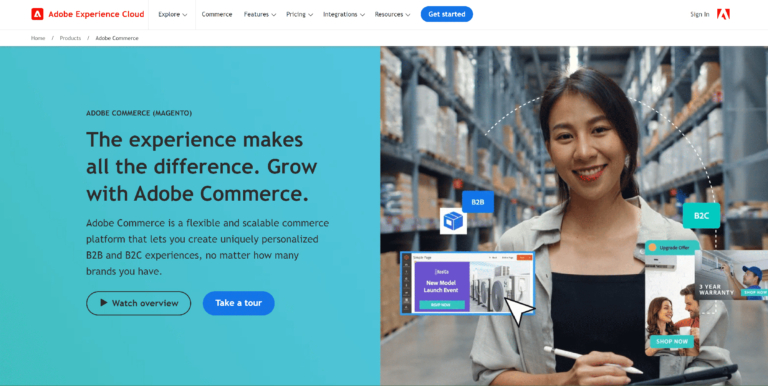Greetings! I'm Aneesh Sreedharan, CEO of 2Hats Logic Solutions. At 2Hats Logic Solutions, we are dedicated to providing technical expertise and resolving your concerns in the world of technology. Our blog page serves as a resource where we share insights and experiences, offering valuable perspectives on your queries.

Ever feel like BigCommerce is holding you back?
You have a clear vision for your store, but the platform’s templates and limited customization don’t cut it. Every small change seems to need a developer, and it’s frustrating, right? Your store should reflect your brand, not be stuck in the same mold as everyone else’s.
What if there’s a better platform that gives you more control and flexibility? Explore BigCommerce alternatives to help you build the store you’ve always wanted.
Executive Summary
Key Findings for Busy Decision-Makers
- Scalability Issues: Many businesses outgrow BigCommerce as they scale, facing challenges with traffic management and product SKU limits that can hinder growth.
- Cost Considerations: A detailed cost-benefit analysis indicates that alternative platforms may offer better pricing structures and lower transaction fees, improving profit margins.
- Integration Opportunities: Top alternatives often provide more robust integration capabilities with ERP, CRM, and marketing tools, enhancing overall business efficiency.
Comparison Overview
| Platform | Key Strengths |
| Shopify plus | Quick setup, an extensive app marketplace |
| Adobe Commerce (Magento) | Strong B2B features, extensive customization |
| Shopware Enterprise | Experience-driven features, appealing to European brands |
| WooCommerce | Low initial cost, perfect for WordPress users |
| Squarespace Commerce | Excellent for content-driven brands, effective storytelling |
Why Consider BigCommerce Alternatives?
As your e-commerce business grows, the limitations of your existing platform may become increasingly apparent. Factors such as:
- Limited scalability
- Lack of flexibility
- Rising costs
This may limit your adaptability concerning changes within market trends and customers’ specific needs. Finding alternatives to BigCommerce opens one’s avenues towards smooth operation, a better customer experience, and faster growth.
Evaluation Criteria for Your Next E-commerce Platform
When evaluating potential BigCommerce alternatives, it’s essential to consider a range of factors, including:
- Scalability and flexibility
- User-friendliness and user interface
- Mobile responsiveness and omnichannel capabilities
- Payment gateway integration and security
- SEO-friendly features and performance
- Inventory management and order fulfillment
- Third-party integrations and ecosystem
- Customer support and overall value
Top 5 BigCommerce Alternatives
1. Shopify Plus
Shopify Plus is the go-to solution for high-growth Direct-to-Consumer (D2C) brands looking to scale without technical limitations.

Key Differentiators for Enterprise
Shopify Plus elevates the standard Shopify experience with enterprise-grade features:
- Advanced API capabilities
- Multiple storefront capabilities
- Customizable checkout experience
- Unlimited bandwidth and transactions
- Dedicated account management
Pricing Model and Hidden Costs
While Shopify Plus’s pricing starts at $2,000 per month, it’s important to consider the full financial picture:
- Transaction fees of 0.15% apply if you’re not using Shopify Payments
- Additional costs may include:
- Third-party apps and integrations for extended functionality
- Custom development work for specialized features
- Premium themes or custom design work
Migration Complexity: Medium
Transitioning to Shopify Plus services is efficient but requires careful planning:
- Built-in migration tools
- Data mapping required for complex catalogs
- Extensive partner network for assistance
- API-based migration possible
Customer Success Story
The MVMT Watches is a perfect example of Shopify Plus’s scalability. Initially, it was crowdfunded and utilizing the application’s robust features, expanded from 1M to 100M in sales. MVMT benefited from the platform through flash sales where the automation of orders ensured the brand was prepared for a large surge in orders.
2. Adobe Commerce (Magento)
Adobe Commerce formerly known as Magento is now the platform for large B2B enterprises with high customization requirements for their e-commerce platforms.

B2B-specific Features
Adobe Commerce excels in B2B functionalities, offering:
- Complex pricing rules and customer-specific catalogs
- Advanced inventory management
- Multiple organization account structures
- Sophisticated workflow approvals
- Integration with ERP systems
Pricing Model and Hidden Costs
Understanding Adobe Commerce’s cost structure is crucial for budgeting:
- License fees begin at $22,000 per year, but this is just the starting point.
- Additional investments typically include:
- Hosting costs, which can be substantial for high-traffic sites
- Development and maintenance expenses for custom features
- Regular security patches and updates
- Extensions and integrations to enhance functionality.
Customer Success Story
Coca-Cola used Adobe Commerce for its B2B ordering platform to streamline operations across 7 European countries with complex pricing and multiple user roles.
3. Shopware
Shopware 6 is a compelling choice for mid-market businesses eyeing European expansion. This German-engineered platform combines robust commerce capabilities with sophisticated experience-driven features.

Unique Experience-driven Commerce Features
- Shopping Worlds (visual content management)
- Rule Builder for personalization
- Advanced SEO tools
- Multi-language and multi-currency support
- PWA and headless capabilities
Pricing Model and Hidden Costs
Shopware has an enterprise pricing structure,
- Shopware Enterprise license is custom priced but usually begins at €2,500/month.
The whole investment could include:
- Hosting and infrastructure costs vary with traffic and complexity
- Custom development for unique feature requests and integrations
- Premium plugins from Shopware’s marketplace
- Tiered support packages for peak performance
Migration Complexity: Medium-High
Transitioning to Shopware requires careful planning but offers robust tools:
- Native Migration Tools are Provided
- Data Mapping Required
- Complex for Specific Custom Features
- Built-in European Compliance
Customer Success Story
Marc O’Polo, a leading fashion retailer, migrated from BigCommerce to Shopware. This was a great success using the experience-driven features of Shopware since it managed to lift conversion by a remarkable 20%. This better customer experience and fast page loading improved brand perception across several European markets.
4. WooCommerce
For businesses deeply integrated with WordPress, WooCommerce offers a natural extension into e-commerce. This open-source platform transforms your content management system into a powerful online store.

Customization Potential
The greatest strength of WooCommerce is its unparalleled flexibility:
- Source code fully available
- Network of plugins (over 55,000+ WordPress)
- Custom theme development
- Content management system integrated
- RESTful API support
Pricing Model and Hidden Costs
While WooCommerce itself is free, building a professional store requires investment:
- WooCommerce source platform costs nothing. A full solution though includes
- Hosting according to traffic
- Premium themes ($30-$100)
- Basic plugins ($200-$1000+ a year)
- Development and maintenance
- Security management
Migration Complexity: Medium
Moving to WooCommerce combines familiar WordPress elements with e-commerce complexities:
- Various migration plugins are available
- Knowledge of WordPress is required
- Database optimization needed for large catalogs
- Content migrations would be complicated
Customer Success Story
Premium quality meat delivery company Porter & York showcases WooCommerce’s development service’s potential. Using this platform’s great flexibility, they could design a customized shopping experience. The result is a surprising jump of 200% in sales online and through detailed storytelling about the products and simplifying the checkout process.
5. Squarespace Commerce Advanced
Squarespace Commerce Advanced caters to all those businesses for which brand story and product are synonymous. This is a phenomenal site that makes any online shop appealing and content-rich.

Brand Storytelling Features
Squarespace’s commerce solution turns your products into part of your brand narrative:
- Award-winning templates
- Blogging integrated platform
- Social media integration
- Video backgrounds
- Custom CSS/JavaScript capability
Pricing Model and Hidden Costs
Squarespace offers transparent pricing with some additional considerations:
Squarespace Commerce’s base cost is about $40/month (billed annually) and the most essential features
- Additional costs:
- Transaction fees (0% with Squarespace payments)
- Premium integrations
- G Suite licenses
- Custom domain
Migration Complexity: Low
Squarespace prioritizes ease of use in its migration process:
- User-friendly import tools
- Limited options for customizing
- Clean content migration
- May not easily replicate certain features
Customer Success Story
Art gallery BTWN Exhibits demonstrates the potential of Squarespace Commerce Advanced for content-driven businesses. Website merges exhibition content with e-commerce whereby visitors can make purchases for prints and merchandise and view the contents of galleries.
They’ve boasted a 150% increase in online sales since opening their Squarespace store, and they have been featured in several design blogs for the elegant integration of content and commerce.
Making the Final Decision
Compare the BigCommerce alternatives on various points crucial for your business needs, budget, and expansion plans. Engage with vendors, request demos, and thoroughly assess the total cost of ownership, integration capabilities, and overall user experience.
A structured decision-making process is essential to selecting an e-commerce platform that aligns with your brand’s goals. If you’re uncertain about the options, our e-commerce agency specialists are available to provide expert guidance.
Conclusion
Choosing the right e-commerce platform is a wise decision that either enhances your business growth and profitability or not. Comparing the best BigCommerce alternatives and understanding how they fit your needs can help your brand find new opportunities to succeed in the constantly evolving market. Take the time to make an informed choice and position your e-commerce business for long-term success.
Reach out to us, if you have further queries.
FAQ
What are the key reasons to consider switching from BigCommerce?
Reasons to migrate to other e-commerce platforms from Bigcommerce include scalability and flexibility challenges, limited customization options, difficulty in integrating with third-party systems, integration cost, and concern over ownership and lack of omnichannel experiences for customers.
How can I evaluate the different BigCommerce alternatives?
To evaluate the different BigCommerce alternatives:
Assess the platform's scalability, user-friendliness, and mobile responsiveness
Compare the pricing of various e-commerce platforms and choose based on your budget
Evaluate the available payment gateway integrations, security features, and SEO capabilities
Examine the inventory management and order fulfillment functionalities
Assess the platform's third-party integration ecosystem and customer support.
Which BigCommerce alternative is the best fit for my business?
The best alternative depends on your specific business requirements, budget, and growth aspirations. Review the features and capabilities of the platforms, and consider factors such as ease of use, scalability, customization options, and total cost of ownership. To be sure about your choice, engage with vendors, request demos, and seek recommendations from industry experts.
How to ensure a smooth migration from BigCommerce to another platform?
To ensure a smooth migration:
Develop a detailed migration plan that addresses data transfer, URL redirects, and integration with existing systems
Work closely with your chosen platform's support team to ensure a seamless transition
Communicate the changes to your customers and provide them with a consistent brand experience
What are the key considerations when choosing between a hosted (SaaS) and self-hosted e-commerce platform?
Hosted solutions (e.g., Shopify, Salesforce Commerce Cloud)- Easy to use, automatic updates, less maintenance
You get far more control over your data using Self-hosted platforms such as WooCommerce or Magento, but you need much more technical expertise.

Related Articles






